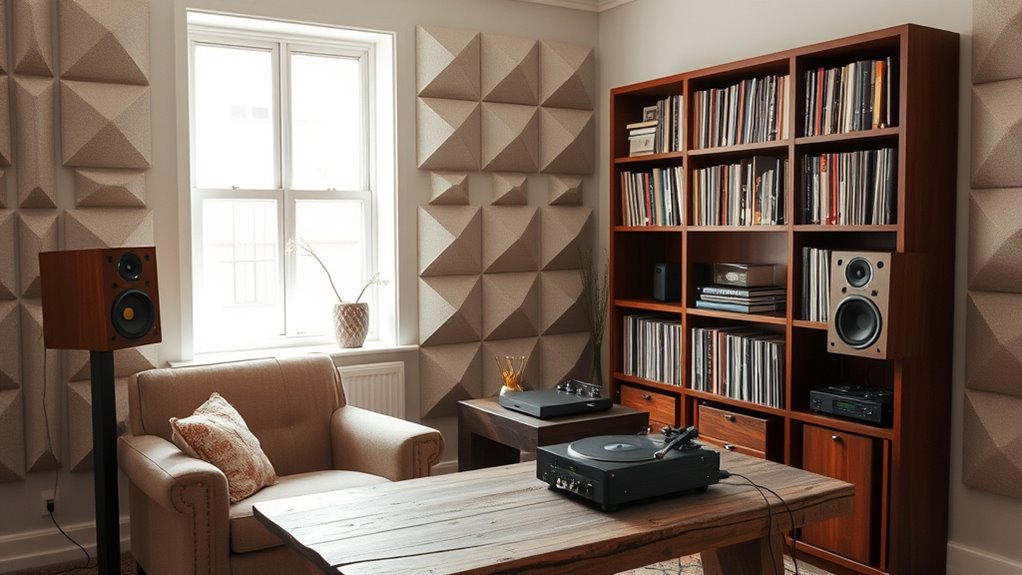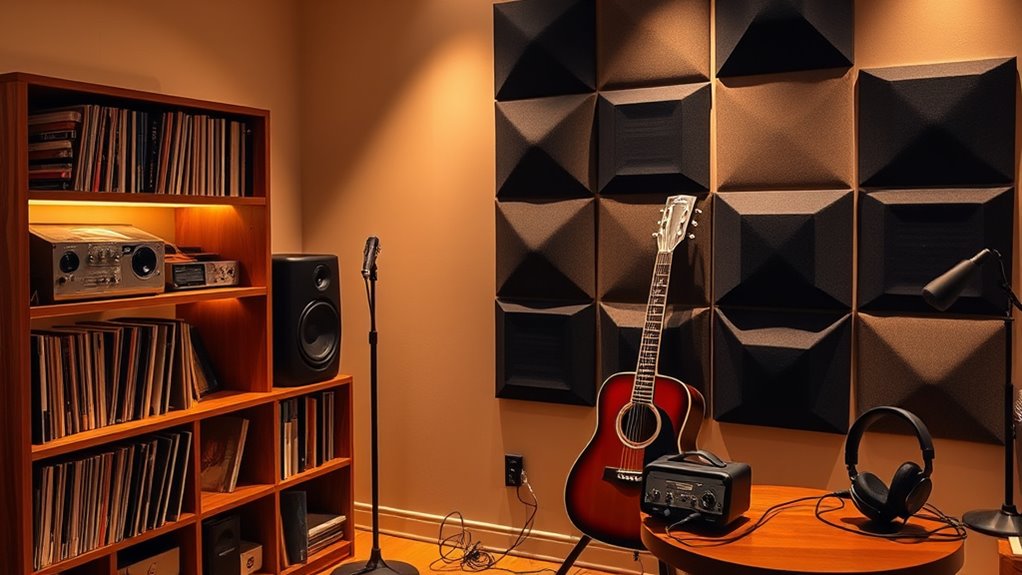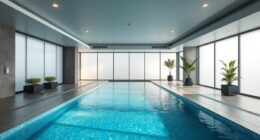To create a great home music corner, choose a quiet spot away from shared walls or bedrooms. Use soundproofing materials like acoustic panels, thick curtains, and rugs to reduce noise and echo. Position your speakers at ear level, forming an equilateral triangle with your listening spot, and avoid placing them against walls. Organizing furniture and cables helps improve sound quality and safety. Keep fine-tuning your setup to balance sound isolation with excellent acoustics, and you’ll discover more ways to enhance your space.
Key Takeaways
- Choose a quiet, isolated corner and use soundproofing materials like acoustic panels and heavy curtains.
- Position speakers at ear level, forming an equilateral triangle with your listening spot, avoiding walls or corners.
- Incorporate furniture, rugs, and soft lighting to absorb sound reflections and improve acoustic quality.
- Organize and fine-tune equipment placement, adjusting speaker angles and furniture for optimal sound clarity.
- Balance soundproofing and acoustics to create a functional, comfortable space conducive to focused music practice.

Have you ever wondered how to transform a corner of your home into the perfect music nook? Creating an ideal space for practicing, recording, or simply enjoying your music requires more than just setting up your gear; it involves thoughtful planning of acoustics and layout. One of the biggest hurdles you’ll face is soundproofing challenges. You want to keep the noise contained so it doesn’t disturb others, but also prevent external noise from interfering with your sound quality. To tackle this, start by selecting a quiet corner, ideally away from bedrooms or shared walls. Then, consider adding soundproofing materials like acoustic foam panels, mass-loaded vinyl, or thick curtains to absorb and block sound waves. Rugs and heavy furniture can also help reduce echo and prevent sound leakage.
Transform a home corner into a music haven with soundproofing and thoughtful layout for perfect acoustics.
Next, think about your equipment placement. Proper positioning of your instruments, speakers, and recording devices is essential for achieving the best acoustics. Place your speakers at ear level, forming an equilateral triangle with your listening position, to get a clear, balanced sound. Avoid placing them directly against walls or corners, as this can cause unwanted bass buildup or reflections that muddy the sound. Instead, try setting them slightly away from surfaces, using stands or isolation pads to minimize vibrations. When positioning microphones, keep them at appropriate distances from your instruments to capture a natural tone, and avoid placing them near reflective surfaces that could cause echo or phase issues.
Lighting and furniture also influence your sound environment. Use soft, diffused lighting to create a comfortable atmosphere, and incorporate furniture that can help with sound absorption—like bookshelves filled with books or plush chairs. These elements reduce sound reflections and help keep your space acoustically balanced. Remember, equipment placement isn’t just about convenience; it’s about optimizing sound quality and ensuring your gear functions effectively. Keep cables organized and out of the way to prevent tripping hazards and accidental disconnections.
Finally, test your setup by playing different types of music or recordings and listening carefully. Adjust speaker angles, furniture placement, and soundproofing materials as needed. It’s a process of fine-tuning to find what works best for your specific space. With patience and attention to detail, your corner will evolve into a functional, acoustically pleasing music nook, where creativity flows freely and sound quality is always premier.
Frequently Asked Questions
How Do I Choose the Best Speakers for My Room Size?
To choose the best speakers for your room size, consider the space you have and your listening habits. Smaller rooms benefit from compact speakers placed close to walls, while larger rooms need bigger speakers with more power. Focus on proper speaker placement and room tuning to optimize sound quality. Experiment with positioning, adjusting angles, and adding acoustic treatments to enhance clarity and guarantee your speakers suit your room’s size and acoustics.
What Are the Signs of Poor Room Acoustics?
You’ll notice poor room acoustics if sound reflection causes echo issues or muddled audio. It might feel like music is bouncing around excessively, making it hard to hear clarity. You could also experience uneven sound distribution, with some spots overly loud or dull. If you detect persistent echo issues or excessive reverberation, those are clear signs your room’s acoustics need attention to improve sound quality.
How Can I Reduce Background Noise During Practice?
To reduce background noise during practice, start by using soundproofing techniques like adding heavy curtains, rugs, and foam panels to absorb sound. You can also use noise-canceling devices or white noise machines to mask external sounds. Imagine sealing your space like an acoustic cocoon—these steps make your practice quieter and more focused, ensuring you won’t be distracted or disturb others nearby.
What Equipment Is Essential for a Beginner Home Studio?
To start your home studio, you need studio monitors and an audio interface. Studio monitors give you accurate sound for mixing, while an audio interface connects your instruments and microphone to your computer. You should also get a good microphone, headphones, and some acoustic treatment to improve sound quality. This essential equipment helps you produce clear recordings and makes your practice sessions more effective.
How Often Should I Calibrate My Audio Setup?
You should calibrate your audio setup every few months to keep it sounding ideal. When doing so, check your speaker placement and verify your acoustic treatment is effective. Proper speaker positioning and reflective surface control help maintain accurate sound. Regular calibration allows you to catch any shifts in sound quality, ensuring your mixes stay precise. Don’t forget to re-evaluate your acoustic treatment if you notice changes in your room’s acoustics over time.
Conclusion
Now that you understand how proper acoustics and setup enhance your home music experience, it’s clear you can create a professional sound environment. Did you know that proper room treatment can improve sound quality by up to 60%? By investing time in your space, you’ll enjoy richer, clearer music every time you hit play. Remember, your perfect sound isn’t just about equipment—it’s about how your room works with it. Happy listening!









